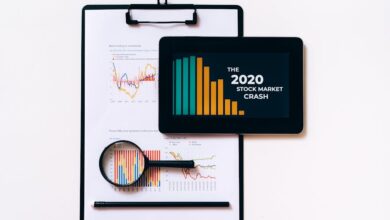Weathering the Economic Storm: Recognizing Recession Signs and Strategies for Resilience

In an increasingly interconnected global economy, the specter of recession looms large, prompting both individuals and businesses to seek clarity amid uncertainty. As economic cycles fluctuate, recognizing the early warning signs of a recession becomes crucial for proactive planning and risk management. This article delves into the multifaceted nature of recessions, exploring how they impact various sectors, alter consumer behavior, and reshape global trade and supply chains. We will also examine effective investment strategies for navigating downturns and the pivotal role of government stimulus in cushioning the blow. By analyzing lessons from past recessions, we aim to equip readers with insights and strategies to better prepare for and survive economic challenges. Understanding these dynamics is essential not only for safeguarding financial well-being but also for fostering resilience in an ever-evolving economic landscape.
- 1. **Identifying the Warning Signs: Early Indicators of Economic Recession**
- 2. **Navigating the Storm: Understanding Recession Impacts on Various Economic Sectors**
1. **Identifying the Warning Signs: Early Indicators of Economic Recession**
Identifying the early warning signs of an economic recession is crucial for individuals, businesses, and policymakers to prepare and respond effectively. Several key indicators can signal an impending downturn:
1. **Declining GDP Growth:** A sustained decrease in the Gross Domestic Product (GDP) is one of the most significant indicators of a recession. Two consecutive quarters of negative growth often mark the onset of a recession.
2. **Rising Unemployment Rates:** An increase in unemployment rates typically reflects a slowdown in economic activity. Employers may begin to lay off workers or halt hiring in anticipation of reduced consumer demand.
3. **Decreased Consumer Confidence:** Consumer sentiment surveys can provide insights into how individuals feel about the economy's future. A decline in consumer confidence can lead to decreased spending, further impacting economic growth.
4. **Falling Retail Sales:** A consistent drop in retail sales indicates that consumers are cutting back on expenditures, which can be a precursor to broader economic challenges.
5. **Manufacturing Slowdown:** A decrease in manufacturing output, measured by indices such as the Purchasing Managers' Index (PMI), can signal weakening demand and business investment.
6. **Inverted Yield Curve:** When long-term interest rates fall below short-term rates, it suggests that investors expect economic slowdown, as they seek safer long-term investments.
7. **Tightening Credit Conditions:** A reduction in lending due to increased risk aversion among banks can restrict access to capital for consumers and businesses, slowing economic activity.
8. **Stock Market Volatility:** Significant fluctuations in the stock market may reflect investor uncertainty and can be a leading indicator of economic distress.
By monitoring these early indicators, stakeholders can better anticipate potential recessions and implement strategies to mitigate their impacts. Recognizing these signs early allows for proactive measures, helping to cushion the blow of economic downturns and safeguard financial stability.
Economic recessions often follow a predictable pattern, characterized by a decline in economic activity, rising unemployment, and decreased consumer spending. Early warning signs of an impending recession can include a slowdown in GDP growth, increased inflation rates, and a decline in consumer confidence. Analysts also look for changes in key economic indicators such as housing starts, stock market performance, and business investment trends.
The impact of a recession varies across different sectors of the economy. Industries such as construction and manufacturing may experience significant contractions, while essential services like healthcare and utilities tend to be more resilient. However, consumer discretionary sectors, including retail and hospitality, often suffer due to reduced spending. As consumers tighten their budgets, businesses in these sectors face declining revenues and may need to implement cost-cutting measures.
Investing during a recession requires a strategic approach. Investors often shift their focus to defensive stocks—companies that provide essential goods and services—such as utilities, healthcare, and consumer staples. Bonds may also become more attractive due to their stability compared to equities. Diversification and maintaining liquidity are crucial strategies, as they can help mitigate risks during volatile market conditions.
Government stimulus plays a vital role in alleviating the effects of a recession. Stimulus measures, such as direct payments to individuals, tax relief, and increased public spending, can boost consumer confidence and stimulate demand. Historical examples, such as the fiscal policies enacted during the 2008 financial crisis, demonstrate how timely government intervention can soften the blow of economic downturns.
Consumer behavior typically shifts during recessions, with a noticeable increase in price sensitivity and a preference for value over luxury. Consumers may prioritize necessities, delay large purchases, and seek discounts, prompting businesses to adapt their marketing strategies accordingly.
Globally, recessions can disrupt trade and supply chains, leading to decreased demand for exports and challenges in sourcing materials. International markets may experience slowdowns, affecting global economic interconnectedness. Companies need to be agile, reevaluating their supply chains and diversifying sources to mitigate risks associated with international trade fluctuations.
Lessons learned from past recessions, such as the importance of financial preparedness and adaptability, remain relevant today. Businesses that maintain healthy cash reserves, monitor economic indicators, and develop contingency plans are better positioned to weather economic downturns.
To navigate a recession successfully, businesses should focus on operational efficiency, enhance customer relations, and explore new revenue streams. By being proactive and responsive to changing economic conditions, companies can not only survive but potentially emerge stronger from a recession.
2. **Navigating the Storm: Understanding Recession Impacts on Various Economic Sectors**
Recessions exert a profound impact on various economic sectors, each responding differently based on its inherent characteristics and market dynamics. Understanding these effects is crucial for businesses, investors, and policymakers.
The consumer goods sector often experiences a significant downturn during recessions as households tighten their budgets. Discretionary spending on non-essential items declines, while demand for essential goods—such as groceries and household necessities—tends to remain stable or even increase. Retailers may face challenges in maintaining sales volumes, prompting them to adjust inventory levels and reconsider pricing strategies.
The housing market typically sees a slowdown as potential buyers become more cautious. Mortgage rates, economic uncertainty, and declining consumer confidence can lead to reduced home sales and stagnation in construction projects. Conversely, rental markets may experience increased demand as individuals opt to rent instead of buying homes, leading to varied outcomes within the real estate sector.
The financial services sector can also be heavily affected, with banks facing higher default rates on loans and a decrease in demand for credit. This can result in tighter lending standards, impacting both consumers and businesses looking to invest or expand. Investment firms may also experience volatility in stock markets, leading to shifts in investment strategies.
Manufacturing and export-oriented sectors often suffer from reduced demand both domestically and internationally, leading to production cuts and layoffs. As global trade slows, supply chains can become strained, resulting in longer lead times and increased costs.
Conversely, some sectors may exhibit resilience or even growth during economic downturns. For example, healthcare and utility services remain essential, often maintaining stable demand regardless of economic conditions. Additionally, discount retailers and repair services may see increased patronage as consumers seek cost-saving alternatives.
In summary, the impacts of a recession vary significantly across sectors. Understanding these dynamics allows stakeholders to make informed decisions, adapt strategies, and identify potential opportunities amidst the challenges posed by an economic downturn.
In conclusion, understanding the early warning signs of an economic recession is crucial for individuals, businesses, and policymakers alike. By recognizing these indicators, stakeholders can better prepare for the inevitable challenges that accompany economic downturns. The impacts of a recession ripple through various sectors, highlighting the need for tailored strategies for investment and adaptation.
As consumer behavior shifts during these periods, businesses must remain agile, leveraging lessons learned from past recessions to inform their strategies. Government stimulus plays a vital role in cushioning the effects of a recession, emphasizing the importance of timely and effective policy responses.
Moreover, the interconnectedness of global trade and supply chains means that a recession can have far-reaching consequences beyond national borders. By proactively addressing these dynamics, businesses can not only survive but also emerge stronger from economic adversity. Ultimately, the resilience demonstrated during tough times can serve as a foundation for future growth, reminding us that even in the face of uncertainty, opportunities for innovation and improvement abound.





